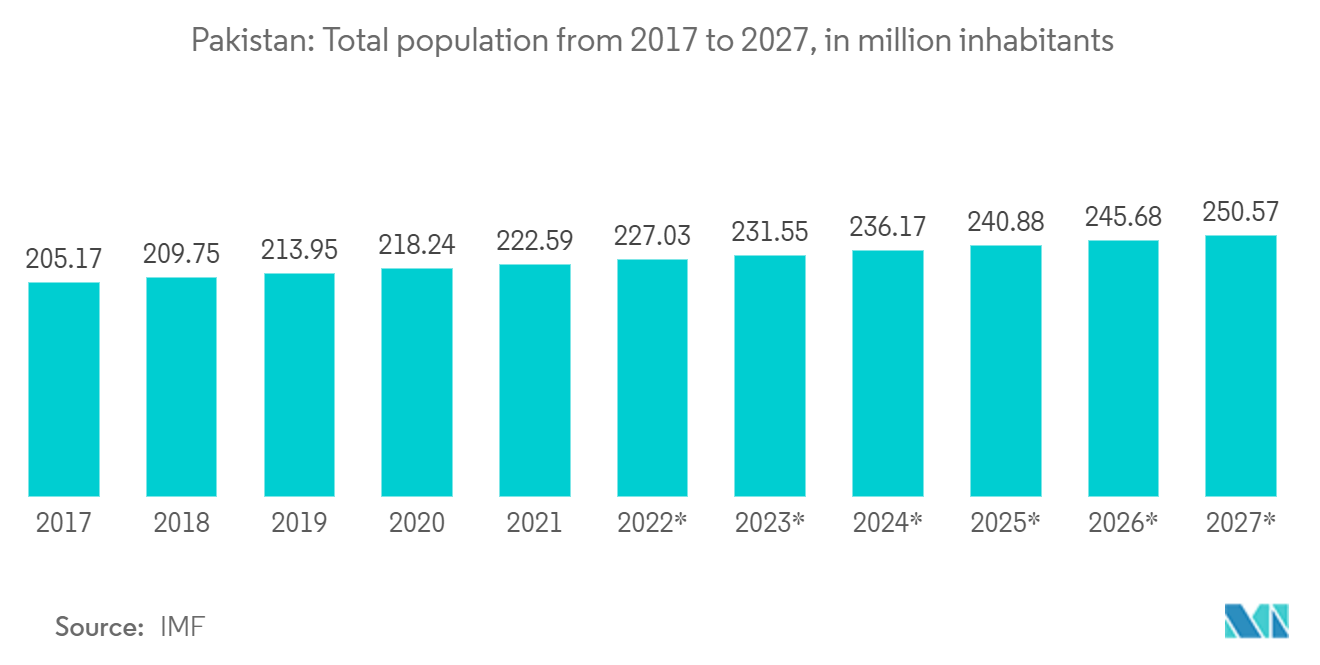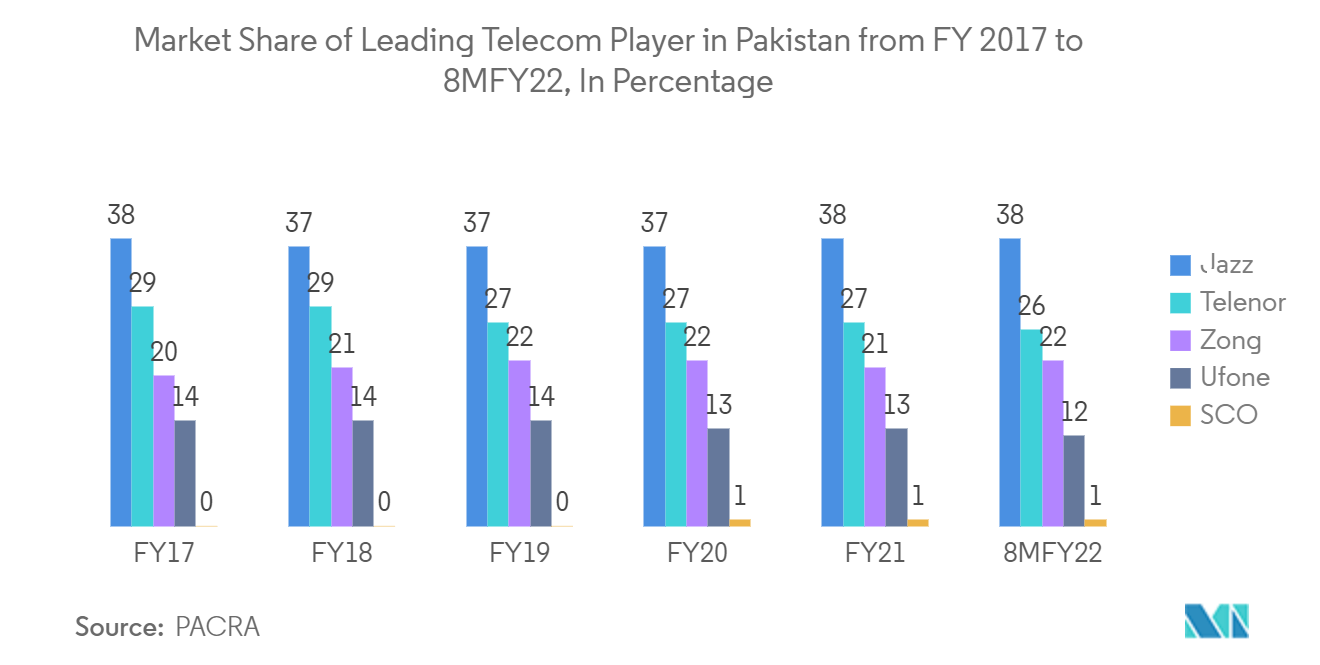Market Trends of Pakistan Telecom Industry
This section covers the major market trends shaping the Pakistan Telecom Market according to our research experts:
Accelerating Digital Transformation
- The pandemic's emergence has been crucial in fostering the growth of digitalization in the telecom sector. Additionally, Pakistan has achieved considerable progress in telecommunications, which has become a crucial driver of the nation's economy. Most businesses have implemented several technologies into their business operations or are in the process of doing so. Pakistani telecoms would provide a superior customer experience as they prepare to modernize and simplify their business processes with the aid of agile digital solutions. Overall, the nation's telecoms environment is expected to shift significantly. One of them, digital transformation, would be crucial in determining the future of the telecoms sector and paving the way for future growth.
- High-speed internet access, digital identity frameworks, and multiple-sided platforms provide the basic components for successful digital citizenship, luxurious digital lives, and a digital economy. Mobile is a part of the Fourth Industrial Revolution's goal of bridging connection gaps, boosting financial inclusion, and sustainably transforming verticals. It is made possible by mobile, which is at the heart of Pakistan's national development strategy and its march along the digital society route. Due to Pakistan's relatively lower fixed internet penetration, the mobile connection is mostly used to access digital services.
- Furthermore, at the event held at PTCL Headquarters, PTCL Group, one of the leading telecom organizations in the nation, tested the 5G technology. The 5G study was run in a constrained setting on an unaffiliated basis. By linking people with reliable, purpose-built technology, 5G would aid in Pakistan's digitalization, creating benefits for both individuals and businesses. Future innovations in industries, including manufacturing, public safety, transportation, and remote education, would be made possible by this technology. Mobile carriers and fixed-wireless providers could deliver richer services and improve client experiences thanks to the technology.
- Notably, in December 2021, a meeting between Ericsson Pakistan and the Ministry of Information Technology and Telecommunication (MoITT) was conducted to discuss digitization, skill development, and engineer training in keeping with the goals of Digital Pakistan. In keeping with the goals of digitalization, Ericsson is dedicated to driving growth and diversification to attract capital and the finest technologies to Pakistan. The company is optimistic about the future of the nation's digital progress following the productive discussion with the Ministry. Moreover, the Pakistan Telecommunication Authority (PTA) and MoITT played crucial roles in the expansion of the country's access to high-quality connectivity and digital services on a national and provincial level. For the people of Pakistan, this has encouraged digital inclusiveness, e-commerce, and a general spirit of entrepreneurship.
- According to IMF, the total population of Pakistan would grow by a total of 23.5 million people (+10.35%) between 2022 and 2027. This prediction states that by 2027, the population will have grown steadily, reaching 250.57 million people. Notably, internet usage across the population has been steadily growing throughout the past few years. At the beginning of 2022, 36.5% of Pakistan's population used the internet. According to Kepios research, between 2021 and 2022, the number of internet users in Pakistan rose by 22 million (+35.9%).

Rising Wireless Density
- Pakistan's wireless or mobile phone sector expanded during the start of the twenty-first century. Pakistan has seen a rise in the number and density of mobile phone users in the last decade. According to PTA data, the semi-urban regions of Punjab province, including Bahawalpur, Sadiqabad, Hyderabad, Abbottabad, and Mardan, have witnessed the highest rates of mobile penetration. The COVID-19-related lockdown limitations have increased the reliance on internet access by making the idea of "work from home" more widespread than ever, thereby increasing the demand for smartphones in the country.
- The YoY increase rate of tele density is generally greater than the average population growth trend. In Pakistan, persons aged 15 to 64 make up around 60% to 65% of the overall population and are considered mobile sim customers. This age group's growth pattern is consistent with the pace of population growth in general. According to PACRA, the country's tele density as of February this year was 88%. Cellular mobile phones accounted for over 99% of all tele density, whereas Wireless Local Loop (WLL) and Fixed Local Loop barely make up 1%. (FLL)
- According to PTA, by the end of June this year, Pakistan had 1.32 million more cellular subscribers than it did at the end of May this year, bringing the total to 194.58 million. The tele density for cellular mobile increased from 87.8% in May to 88.34% by the end of June of this year. By the end of May this year, the total tele-density increased from 88.94% to 89.53% by June. By the end of May 2022, the Monthly Next Generation Mobile Service (NGMS) penetration was 51.73%, and by June this year, it was 52.55%.
- Furthermore, the government intends to shift the trend away from importing things and toward exporting items to assist the economy by encouraging local investors to produce their own high-tech products that can also be sold. In July last year, Pakistani suppliers and retailers of mobile phones imported phones worth USD 119.2 million, while this year, just USD 38.8 million worth of phones were imported. On an annual basis, the imports decreased by 67% compared to last year. To address the demand for mobile phones across the country, Pakistan has excelled in producing local handsets and has progressively started to export mobile phones.
- Pakistan Mobile Telecommunication Limited (Jazz), Telenor Pakistan (Telenor), China Mobile Pakistan Limited (Zong), and Pakistan Telecom Communication Limited (Ufone) are the four major participants in the telecommunications industry. With the most subscribers, Jazz is in the best position. According to a PACRA report, during the first eight months of this year, Jazz had a 38% market share in mobile subscribers, followed by Telenor, which holds a 26% share. SCO, a company that operates solely in Gilgit Baltistan, has the smallest market share. The level of competition is anticipated to rise further as regional businesses employ aggressive tactics to grow their subscriber bases.

